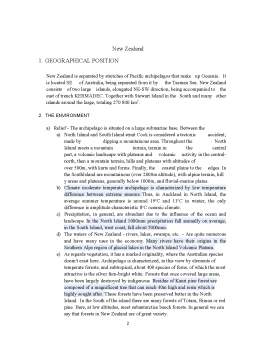Extras din proiect
1. GEOGRAPHICAL POSITION
New Zealand is separated by stretches of Pacific archipelagos that make up Oceania. It is located SE of Australia, being separated from it by the Tasman Sea. New Zealand consists of two large islands, elongated NE-SW direction, being accompanied to the east of trench KERMADEC. Together with Stewart Island in the South and many other islands around the large, totaling 270 840 km2.
2. THE ENVIRONMENT
a) Relief - The archipelago is situated on a large submarine base. Between the
a) North Island and South Island strait Cook is considered a tectonic accident, made by dipping a mountainous area. Throughout the North Island meets a mountain terrain, terrain in the central part, a volcanic landscape with plateaus and volcanic activity in the central-north, then a mountain terrain, hills and plateaus with altitudes of over 500m, with karts and forms. Finally, the coastal plains to the edges. In the SouthIsland are mountainous (over 2000m altitude), with alpine terrain, hilly areas and plateaus, generally below 1000m, and fluvial-marine plains.
b) Climate moderate temperate archipelago is characterized by low temperature difference between extreme seasons. Thus, in Auckland in North Island, the average summer temperature is around 19ºC and 11ºC in winter, the only difference is amplitude characteristic 8ºC oceanic climate.
c) Precipitation, in general, are abundant due to the influence of the ocean and landscape. In the North Island 1000mm precipitation fall annually on average, in the South Island, west coast, fall about 5000mm.
d) The waters of New Zealand - rivers, lakes, swamps, etc.. - Are quite numerous and have many uses in the economy. Many rivers have their origins in the Southern Alps region of glacial lakes in the North Island Volcanic Plateau.
e) As regards vegetation, it has a marked originality, where the Australian species doesn't exist here. Archipelago is characterized, in this view by elements of temperate forests, and subtropical, about 400 species of ferns, of which the most attractive is the silver fern-bright white. Forests that once covered large areas, have been largely destroyed by indigenous. Residue of Kauri pine forest are composed of a magnificent tree that can reach 40m high and resin which is highly sought after. These forests have been preserved better in the North Island. In the South of the island there are many forests of Totara, Rimau or red pine. Here, at low altitudes, meet subantarctice beech forests. In general we can say that forests in New Zealand are of great variety.
f) Also shows an increased fauna endemic. It was and is the birth place of many Kiwi birds, midwives, the acclimatized animals: marsupials, mammals (boar. ermine), trout, etc
3. .POPULATION AND SETTLEMENTS
It was populated by Maori, whose migration from Hawaiki and other islands of Polynesia took place in several waves, between sec. XII-XIV e.n. Currently living maorii especially the northern tip of North Island, showing a marked trend in recent decades to settle in cities.
New Zealand's population has varied over the years:
- In 1978, New Zealand's population was 3,195,000 inhabitants, representing almost 300,000 Maori.
- In 1979, the state's population decreased by 11,600 people.
- Currently, the state's population is approximately 3.6 million inhabitants.
The birth rate is declining:
- 26.2 ‰ in 1962
- 22 ‰ in 1970
- 17.3 ‰ in 1978
Maori population growth rate is double the average total population, while infant mortality in this group still remain high.
The average population density is only 13 inh./km2.
The most populated regions correspond to peripheral sectors of the North Island, plus Conterbury province of South Island and the population of rare (less than 5 inh./km2) meets the vast mountainous strip that runs through the South Island and Central Volcanic Plateau of the North Island.
MAJOR CITIES:
• Wellington (351 000 inhabitants, with Hutt City), the state capital;
• Auckland (804 200 inhabitants), the largest city in New Zealand;
• Christchurch
4. ECONOMY
New Zealand is known as a country whose economy is dominated primarily by agriculture and animal husbandry sector, which has some of the first places in the world. A long time New Zealand's economic role was to supply the British market with milk, dairy products, meat and wool. This dependence on exports and favorable natural conditions to agriculture, on the one hand, a series of stringent objective factors, on the other hand, have led to falling behind the industry of agriculture. Economic activities(industry, agriculture, transport, trade inside and outside) are unevenly distributed in the North Island occupies a privileged position in all these areas and the imbalance occurred between the two large islands tend to grow.
5. INDUSTRY
The recent boom in this sector of the economy has become possiblefollowing intensive use of hydropower resources through upgrading of the natural gas deposits of iron ore by massive imports of raw materials and semifinished products forindustrialization. New Zealand industry is still primarily oriented towards satisfying domestic demand. As mentioned, the gap between the two large islands of industrialization are always amplified for the North Island, although in recent decades industry Christchurch City had a remarkable development, and in other South Island regions of large modern enterprises have been created or was enlarged existing ones(aluminum, the Bluff, cement, at Newport, in Westland).
Preview document
Conținut arhivă zip
- New Zealand.doc
- New Zealand.ppt














